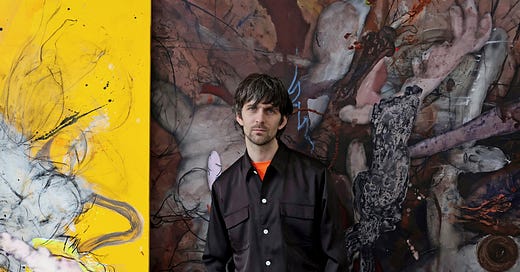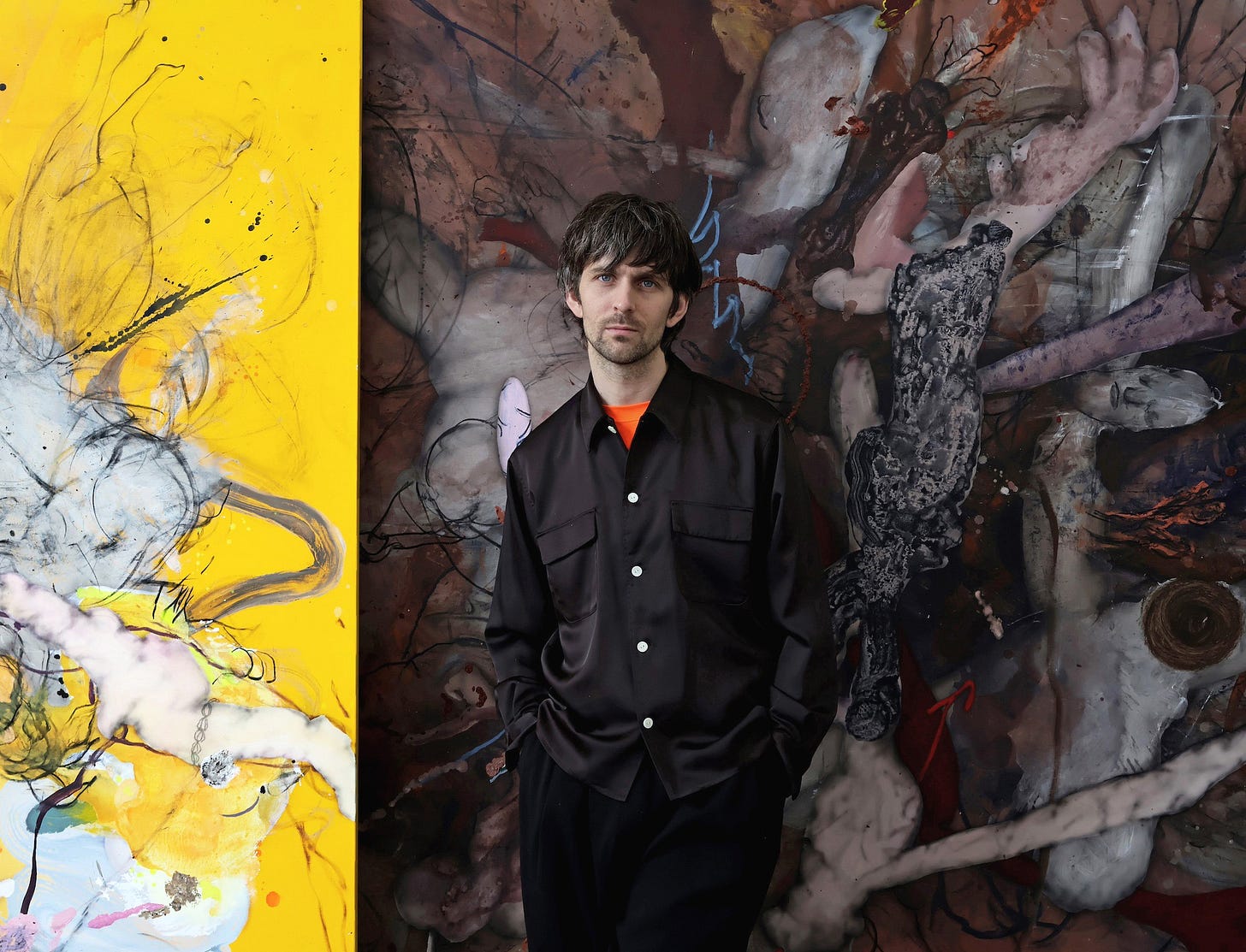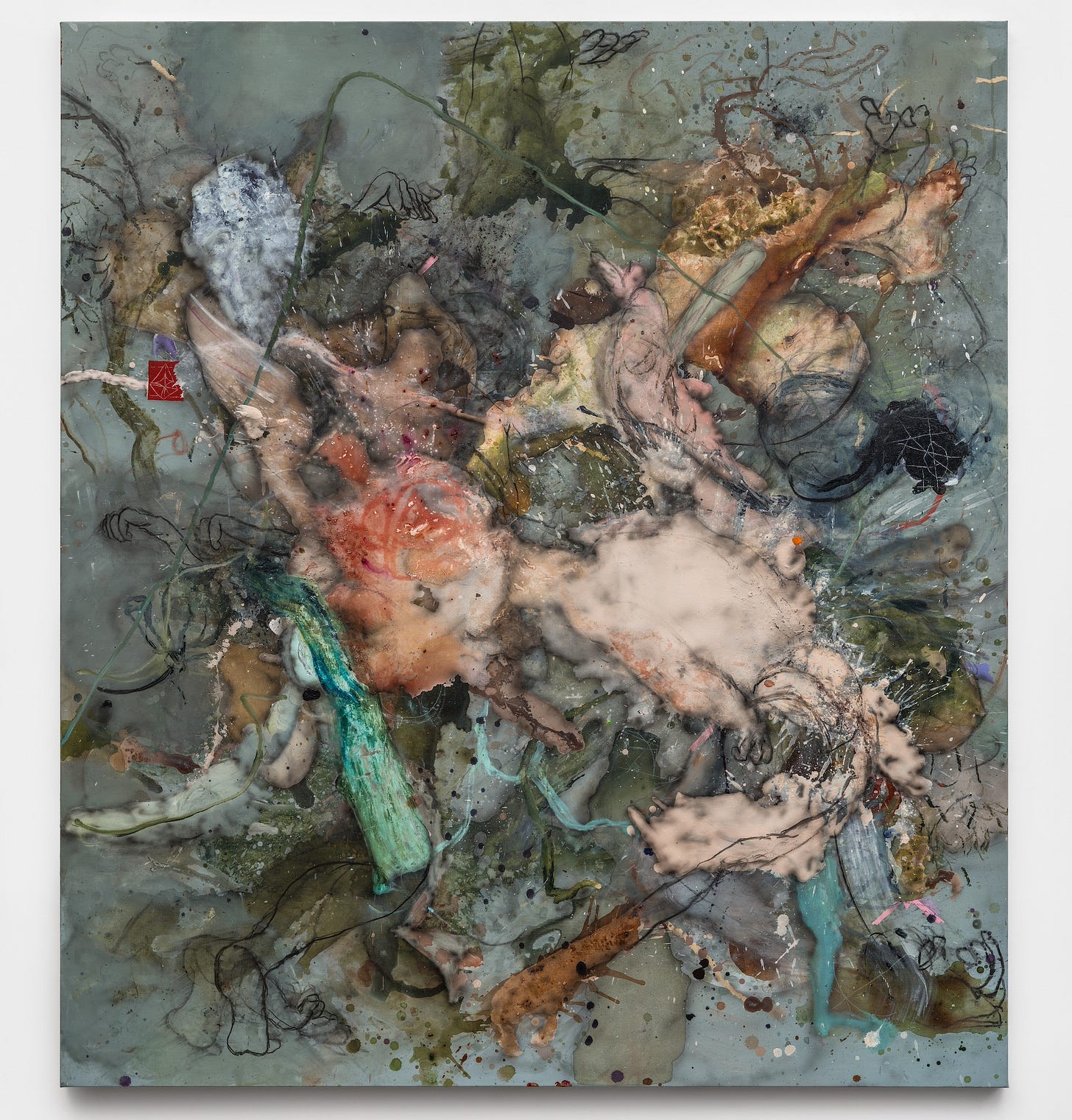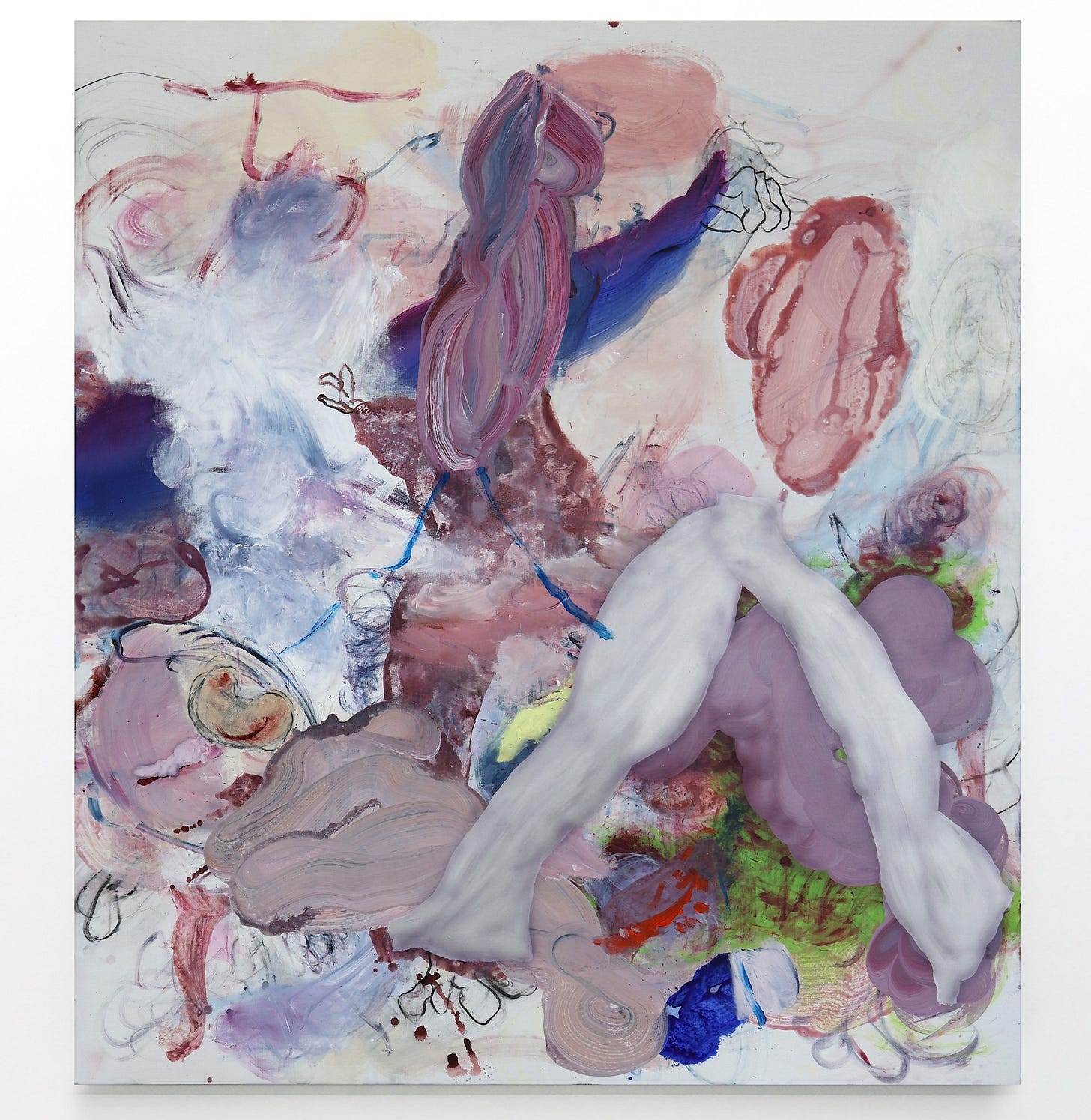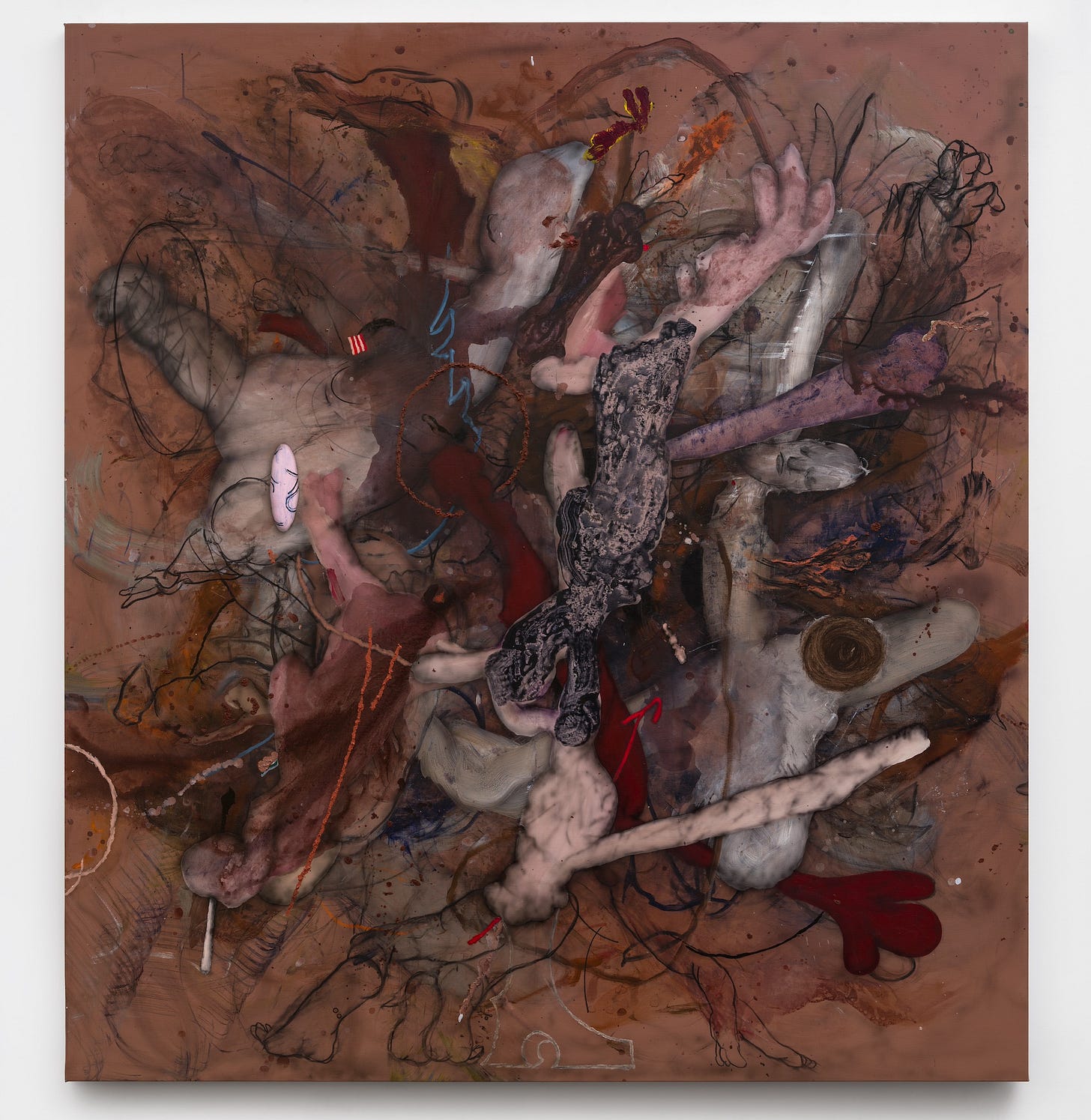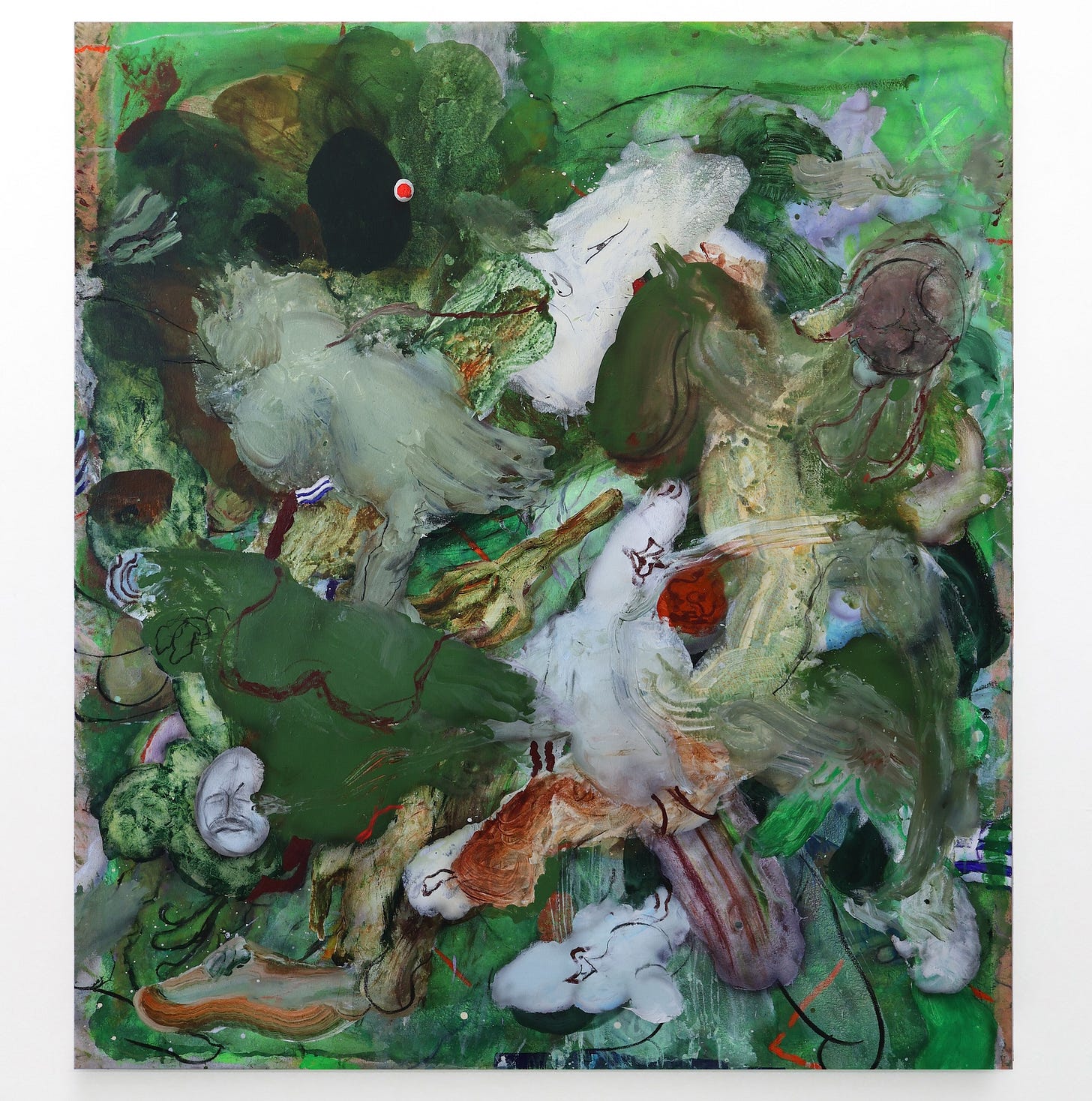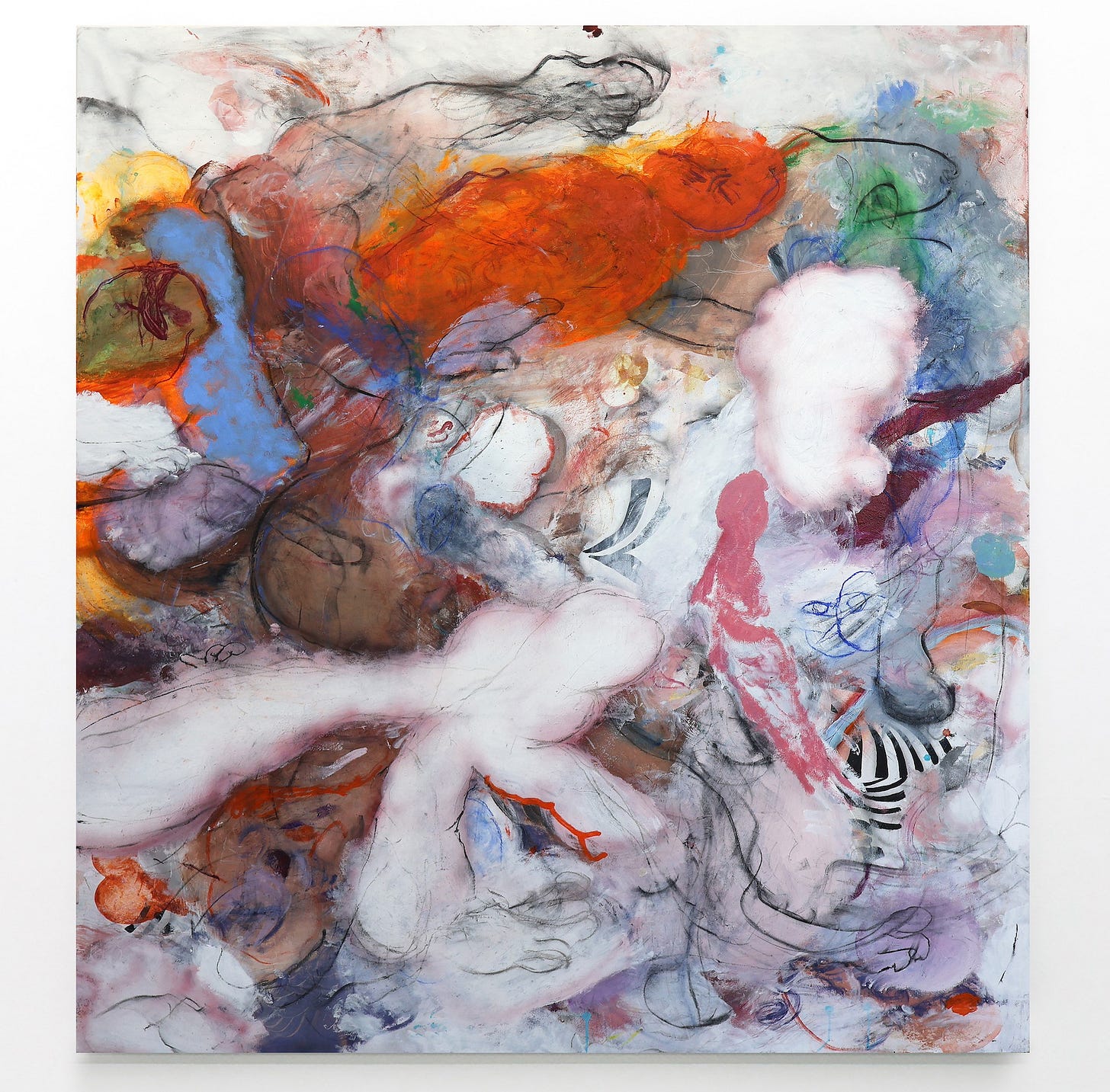When I first saw Nick Modrzewski’s paintings I was immediately drawn to their wild chaos. There was so much to enjoy: swirling forms, thin drawing elements, little repetitions, different parts overlapping, pools of paint seeping into other pools of paint, glimpses of colour peeking out from former layers. Nick’s paintings are the kind of paintings I can come back to and notice different things each time.
And yet, Nick’s work wasn’t the straightforward abstract painting I had originally thought it to be. Closer inspection reveals his use of charcoal and suggestions of figurative forms amidst the chaos. His gestures hint at some kind of reference material and a deeper engagement with drawing in his practice. I particularly love how these details are never presented with clarity, but rather, wilfully buried in abstract forms, creating a kind of intrigue that invites you to investigate his mesmerising surfaces.
I sensed there were some secrets embedded in the paint of Nick’s beautifully ambiguous works, so I reached out to him on his return to LA (where he is currently based) from his show at COMA in Australia (where he is originally from).
Hey Nick. I was sad to miss your solo show at Sarah Kravitz in London last year. Did you make it over, and were you happy with the show?
It was my first solo in London, so it was great to be there for the opening. And yes, I’m happy with the paintings! The show was called Social Ledger. At the time I was thinking about painting as a form of record-keeping – the way that marks and gestures are built up, erased and overlayered – it both reveals and disguises its own history.
I’d been reading about social ledger theory, which is the idea that you can ‘log’ your social interactions as positive ‘assets’ or negative ‘liabilities,’ just like an accounting ledger. It’s a funny way to think about inter-personal relationships, as ‘entries’ in an administrative system. But it struck me as an interesting framework to think about representing the human body as it moves across different social scenarios. So, for the exhibition, each of the paintings acts as a ledger, recording various interactions – a debate, a conversation, a handshake – through an accumulation of gestures, spillages, drawings and erasures. I wanted to capture the ephemeral and often elusive nature of human communication and the ways that the body might become abstracted or distorted as it navigates social constructs.
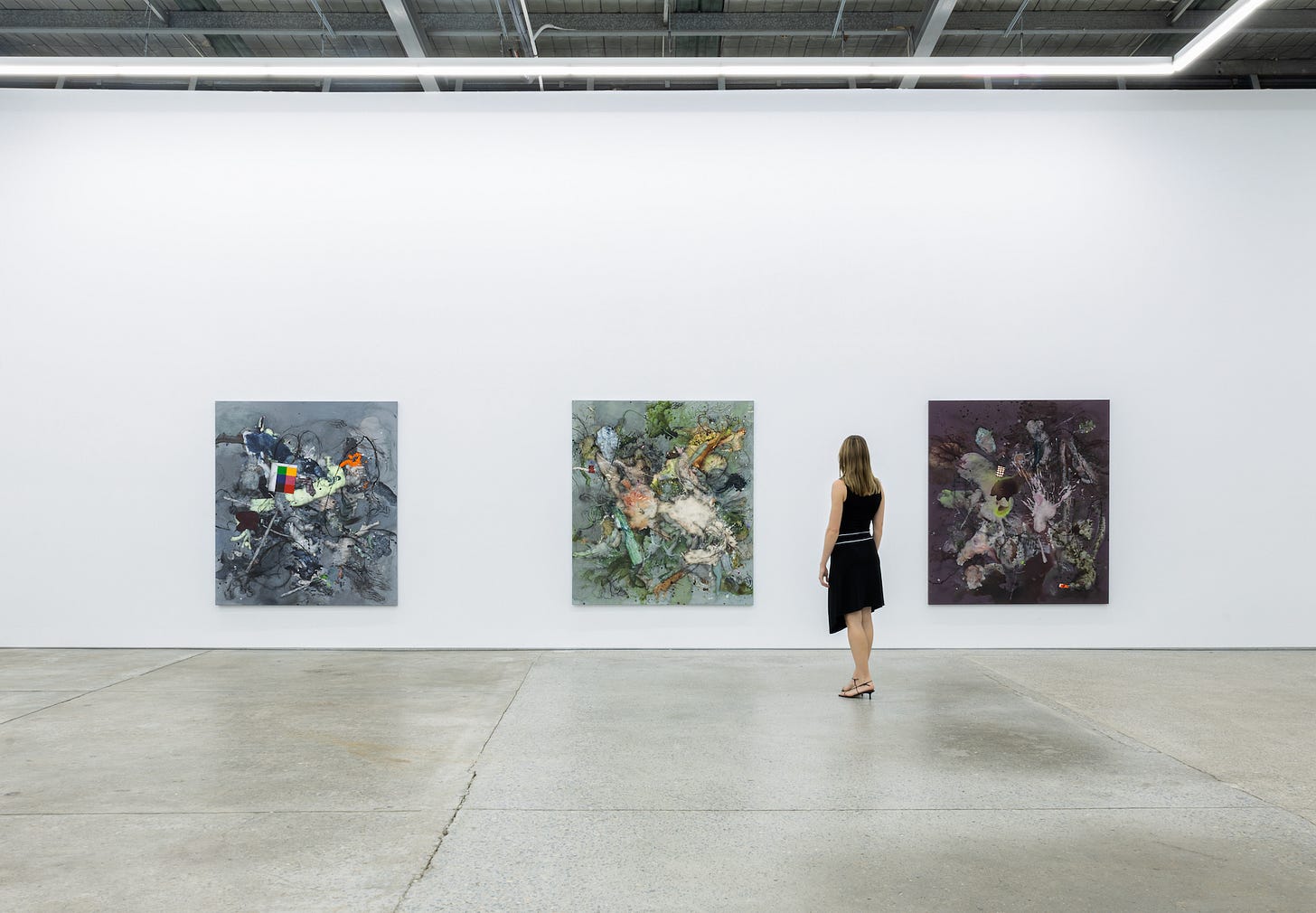
I was fascinated by the sheer variety of marks in your paintings. Do you love having tons of different tools to make marks with? What’s your general approach to that?
Yes, I have a whole arsenal of tools in the studio, there are sponges and rags; sticks, brooms, scrapers, pens, highlighters, an airbrush, pen lids, squeegees, buckets, my hands. I’m trying to bring together a confluence of different techniques that allow me to make and unmake images – to articulate an idea and then to erase it or allow it to morph into something I don’t expect. I want the paintings to feel contradictory, in a way. For instance, I might use the airbrush to lightly feather the surface of a shape, to add a drop-shadow and give it three-dimensionality, before carving into it with the back of a brush, inscribing it with two-dimensionality and partially excavating earlier layers of paint.
How do you start a piece? I can see you use charcoal, perhaps as a drawing element in the early stages of a piece?
There’s a regimen for each painting and different stages that a piece passes through. I start by building up the surface, pouring acrylic ‘soups’ onto the linen, before imposing specific imagery, which subsequently gets partially erased or painted over. Drawing comes in at various stages throughout the process. I love the immediacy of a charcoal line, the way it can cut through wet paint or sit right on top of the surface. It’s so direct – you can get your ideas down quickly, without needing to let things dry, or reload the brush.
The drawing elements in my work now have this definitional function – I use charcoal to turn an amorphous shape into a recognisable image – a thigh or a coin or a dog’s beard. I can ‘animate’ the picture this way, quickly responding to ideas as they arise. I often partially erase the drawings, allowing for a cacophony of different images and mental snapshots to gyrate across the picture plane like stop-motion animation.
I can see bodies and forms in your earlier work that look like they have become increasingly abstracted as of late. Can you speak to that evolution in your work?
You’re right. I used to be a little more literal in my depictions of bodies and scenes. Over time I’ve moved towards a looser, more ambiguous form of representation. I now show bodies in different stages of becoming. I want to capture them as they shift between fluid states, rather than fixing them in space. I want a leg to also maybe be a tree or part of a bicycle. It’s a kind-of restless representation – not wanting to settle on a single image, but to keep reinventing the possibility of what it might be.
I think this is because I distrust stable categories and binary positions. I much prefer grey areas – a swamp rather than a pool. I like murky, in-between places. I sometimes describe my paintings as existing in those moments just before you fall asleep, when you’re partially conscious and not fully in control of the images that flicker at the edge of your mind.
Painting feels particularly adept at occupying these spaces, as it permits you to articulate an idea or a feeling without having to rely on the exactitude of written or spoken language. It allows you to gently massage something nebulous into a physical form, to shepherd it into being while juggling the unpredictability of the material.
What can you tell me about the interests behind your paintings, in terms of what’s simmering in your mind before or during the making of a piece?
I’m interested in the relationship between rational systems and the human body. I used to work as a barrister, so I have a particular interest in legal systems and how they act upon us. We’re these fleshy, visceral clumps moving through an intricately coded network of invisible rules and frameworks – social etiquette; regulation; language, to name a few. I often think of my paintings as depictions of this – how bodies might be stretched and pulled through these administrative codes, dripping and spilling in the process. Many of my solo shows in Australia have explicitly dealt with legal ideas. The Knees and Ankles of a Landlord, at Discordia in Melbourne, looked at some of the real and imagined consequences of the development of property law. Another show, The Plaintiff’s Third Face, at COMA in Sydney was about theatrical role-playing in legal settings. I made 56 sculptural masks for the show, each one loosely referencing the various characters produced and enacted in legal proceedings.
I read that you’re Australian but based in LA? How did you end up there and how has it affected your work?
My wife Nabilah and I moved from Melbourne to LA at the end of 2023. We were planning to move to New York, but we were both offered art opportunities here and so we shifted our plans. For me, moving to LA has opened up many new channels in my paintings. The shifts we spoke about earlier, toward a more gestural, looser form of figuration – all of that happened after moving to LA. I think that whenever you travel to a new setting, your perceptions are tweaked and heightened and that inevitably influences an art practice. Being in LA specifically has been wonderful. I love that the city doesn’t reveal itself immediately – there’s no ‘centre’, it’s a seemingly endless, sprawling congregation of freeways, mini-cities and in-between spaces. It always seems to take at least 40 minutes in the car to get anywhere. It feels un-designed and therefore infinitely open to interpretation and re-imagination.
Lastly, any shows you want to plug?
I currently have a solo up at COMA in Sydney, Misbehaviour in the Age of Geometry, which is on until 5 April. I’m also working on a new body of work for a solo at Lyles and King in New York later this year.
Follow Nick on Instagram: @nickmodrzewski
Things on Our Radar This Week
We wish we could visit this epic Frank Bowling ‘Collage’ show at Hauser & Wirth, Paris. If you’re local go see it and report back!
MoMA just put out a video delving into the mysterious abstractions of Jack Whitten
A fascinating story on a Miró painting that when x-rayed revealed a portrait of his mother that he worked over
The Best Painting Shows in London This Month
The ‘Slab’ group show feat. Kes Richardson at The Bottle Factory (ends this weekend!)
The ‘Place Revisited’ group show at Modern Art EC1 (ends 5 April)
Sim Smith have an exciting group show (ends 19 April)
Tim Stoner at Pace (ends 12 April)
Thanks for reading, see you next time!
Oliver & Kezia xx
Palette Talk is free and we hope to grow with your support. If you’ve enjoyed reading, drop us a donation via PayPal…


